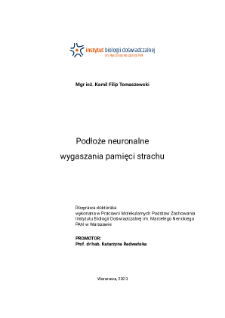
Object
Title: Podłoże neuronalne wygaszania pamięci strachu : praca doktorska
Institutional creator:
Instytut Biologii Doświadczalnej im. Marcelego Nenckiego PAN
Contributor:
Radwańska, Katarzyna (1974- ) : Supervisor
Publisher:
Instytut Biologii Doświadczalnej im. Marcelego Nenckiego PAN
Place of publishing:
Description:
116, [1] pages : illustrations ; 30 cm ; Bibliography ; Summary in English
Degree grantor:
Instytut Biologii Doświadczalnej im. Marcelego Nenckiego PAN
Type of object:
Abstract:
Cellular mechanisms associated with memory consolidation, extinction, and its impairment have been the subject of scientific research for a long time. This is particularly important due to their clinical significance in patients with emotional disorders such as post-traumatic stress disorder (PTSD), anxiety, and phobias. Understanding the neurological correlates of these processes is crucial for a better understanding of the enduring nature of fear memory and the development of new therapies for anxiety disorders in humans. Most studies on fear memory extinction mechanisms focus on recent memory (from a few hours to several days after fear conditioning). At the same time, few studies have focused on late memory (e.g., several weeks after conditioning), although it is certainly more important in the context of long-term emotional disorders. Hence, the neuronal basis of remote fear memory extinction remains mostly unknown. In this dissertation, I present the results of studies on selective impairment of late context-dependent fear memory extinction in mice with impaired autophosphorylation of the alpha isoform of calcium/calmodulin-dependent protein kinase II (αCaMKII) (T286A+/-). To determine the brain regions involved in this process, the expression of the c-Fos protein, which serves as an indicator of neuroplasticity, was examined in 23 brain regions of the mice. Brain regions showing distinct differences in activation during remote fear memory extinction in T286A+/- mice compared to wild-type (WT) mice were then subjected to chemogenetic inhibition using the Designer Receptors Exclusively Activated by Designer Drugs (DREADD) system. Additionally, similar manipulations were performed at the level of neuronal projections between the nucleus reuniens (RE) and the medial septum (MS). The obtained data demonstrate that reduced autophosphorylation of αCaMKII in T286A+/- mice impairs late, but not early, fear memory extinction. The c-Fos expression pattern in the brain of these mice during extinction differs from the pattern in WT mice, suggesting differences in the processes of acquisition and consolidation of remote fear memory extinction. Specifically, after late memory extinction training, hyperactivity was observed in the RE, central-medial (CM) and medio-dorsal (MD) thalamic nuclei and the primary visual cortex (V1) in T286A+/- mice. Furthermore, I observed that remote fear memory extinction depends on the activity of the MS and RE. Chemogenetic inhibition of these structures impairs remote fear memory extinction. Interestingly, inhibiting the RE during recent memory extinction accelerates extinction, revealing the complex role of this brain region in the processes of acquisition and consolidation of fear memory extinction. In contrast, inhibiting the MS at the same time point does not affect the extinction process. Additionally, selective inhibition of glutamatergic neurons in the RE using viral vectors encoding DREADD under the αCaMKII promoter affects fear extinction during the session but has no impact on the consolidation of extinction memory, regardless of whether it is recent or remote memory. Moreover, I demonstrated that chemogenetic inhibition of the RE→MS projection impairs late, but not recent fear memory extinction. In summary, the experiments I conducted revealed the involvement of αCaMKII in the regulation of thalamic activity during long-term consolidation of fear memory. Additionally, I demonstrated the involvement of the RE and MS, as well as the RE→MS projection, in the regulation of remote fear memory extinction.
Detailed Resource Type:
Resource Identifier:
Source:
Language:
Language of abstract:
Digitizing institution:
Nencki Institute of Experimental Biology of the Polish Academy of Sciences
Original in:
Library of the Nencki Institute of Experimental Biology PAS
Projects co-financed by:
Access:
Object collections:
- Digital Repository of Scientific Institutes > Partners' collections > Nencki Institute of Experimental Biology PAS
- Digital Repository of Scientific Institutes > Partners' collections > Nencki Institute of Experimental Biology PAS > Dissertations
- Digital Repository of Scientific Institutes > Partners' collections > Nencki Institute of Experimental Biology PAS > Dissertations > PhD Thesis
- Digital Repository of Scientific Institutes > Literature
- Digital Repository of Scientific Institutes > Literature > Thesis
Last modified:
Dec 22, 2023
In our library since:
Dec 22, 2023
Number of object content downloads / hits:
73
All available object's versions:
https://rcin.org.pl/publication/276490
Show description in RDF format:
Show description in RDFa format:
Show description in OAI-PMH format:
| Edition name | Date |
|---|---|
| Tomaszewski, Kamil Filip, 2023, Podłoże neuronalne wygaszania pamięci strachu : praca doktorska | Dec 22, 2023 |
Objects Similar
Kaźmierowska, Anna Maria
Nowicka, Klaudia
Rojek-Sito, Karolina

 INSTYTUT ARCHEOLOGII I ETNOLOGII POLSKIEJ AKADEMII NAUK
INSTYTUT ARCHEOLOGII I ETNOLOGII POLSKIEJ AKADEMII NAUK
 INSTYTUT BADAŃ LITERACKICH POLSKIEJ AKADEMII NAUK
INSTYTUT BADAŃ LITERACKICH POLSKIEJ AKADEMII NAUK
 INSTYTUT BADAWCZY LEŚNICTWA
INSTYTUT BADAWCZY LEŚNICTWA
 INSTYTUT BIOLOGII DOŚWIADCZALNEJ IM. MARCELEGO NENCKIEGO POLSKIEJ AKADEMII NAUK
INSTYTUT BIOLOGII DOŚWIADCZALNEJ IM. MARCELEGO NENCKIEGO POLSKIEJ AKADEMII NAUK
 INSTYTUT BIOLOGII SSAKÓW POLSKIEJ AKADEMII NAUK
INSTYTUT BIOLOGII SSAKÓW POLSKIEJ AKADEMII NAUK
 INSTYTUT CHEMII FIZYCZNEJ PAN
INSTYTUT CHEMII FIZYCZNEJ PAN
 INSTYTUT CHEMII ORGANICZNEJ PAN
INSTYTUT CHEMII ORGANICZNEJ PAN
 INSTYTUT FILOZOFII I SOCJOLOGII PAN
INSTYTUT FILOZOFII I SOCJOLOGII PAN
 INSTYTUT GEOGRAFII I PRZESTRZENNEGO ZAGOSPODAROWANIA PAN
INSTYTUT GEOGRAFII I PRZESTRZENNEGO ZAGOSPODAROWANIA PAN
 INSTYTUT HISTORII im. TADEUSZA MANTEUFFLA POLSKIEJ AKADEMII NAUK
INSTYTUT HISTORII im. TADEUSZA MANTEUFFLA POLSKIEJ AKADEMII NAUK
 INSTYTUT JĘZYKA POLSKIEGO POLSKIEJ AKADEMII NAUK
INSTYTUT JĘZYKA POLSKIEGO POLSKIEJ AKADEMII NAUK
 INSTYTUT MATEMATYCZNY PAN
INSTYTUT MATEMATYCZNY PAN
 INSTYTUT MEDYCYNY DOŚWIADCZALNEJ I KLINICZNEJ IM.MIROSŁAWA MOSSAKOWSKIEGO POLSKIEJ AKADEMII NAUK
INSTYTUT MEDYCYNY DOŚWIADCZALNEJ I KLINICZNEJ IM.MIROSŁAWA MOSSAKOWSKIEGO POLSKIEJ AKADEMII NAUK
 INSTYTUT PODSTAWOWYCH PROBLEMÓW TECHNIKI PAN
INSTYTUT PODSTAWOWYCH PROBLEMÓW TECHNIKI PAN
 INSTYTUT SLAWISTYKI PAN
INSTYTUT SLAWISTYKI PAN
 SIEĆ BADAWCZA ŁUKASIEWICZ - INSTYTUT TECHNOLOGII MATERIAŁÓW ELEKTRONICZNYCH
SIEĆ BADAWCZA ŁUKASIEWICZ - INSTYTUT TECHNOLOGII MATERIAŁÓW ELEKTRONICZNYCH
 MUZEUM I INSTYTUT ZOOLOGII POLSKIEJ AKADEMII NAUK
MUZEUM I INSTYTUT ZOOLOGII POLSKIEJ AKADEMII NAUK
 INSTYTUT BADAŃ SYSTEMOWYCH PAN
INSTYTUT BADAŃ SYSTEMOWYCH PAN
 INSTYTUT BOTANIKI IM. WŁADYSŁAWA SZAFERA POLSKIEJ AKADEMII NAUK
INSTYTUT BOTANIKI IM. WŁADYSŁAWA SZAFERA POLSKIEJ AKADEMII NAUK


































